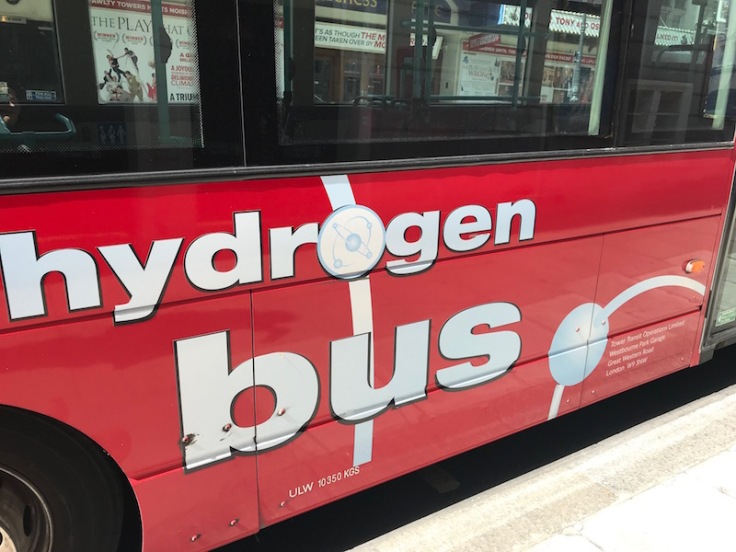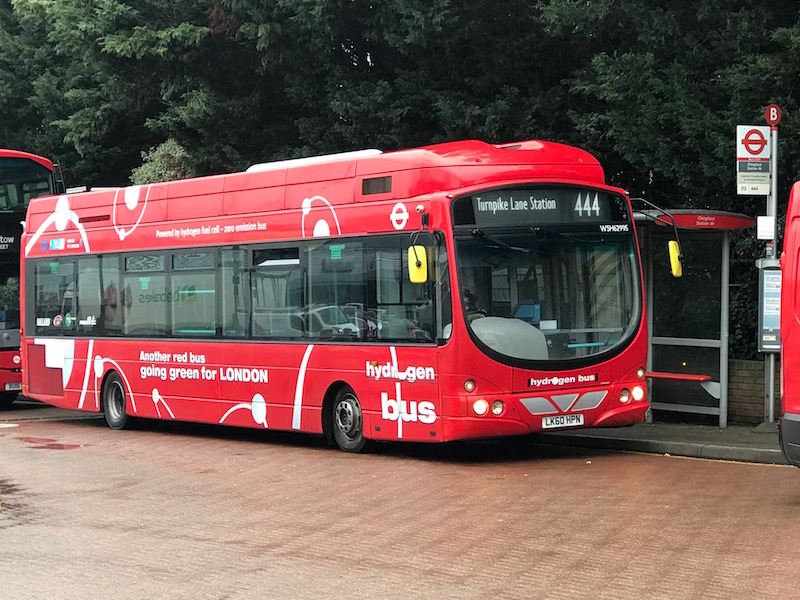Thursday 5th March 2020

TfL’s hydrogen powered single deck buses reach their final terminus tomorrow so I took a couple of rides on board for one last time today.
TfL first trialled hydrogen propulsion for a couple of years from 2004 as part of an EU wide trial in ten cities to test the technology. TfL used three adapted Mercedes Benz Citaros allocated to route RV1, the route which connected Covent Garden and Waterloo Bridge with the South Bank, Southwark, London Bridge, Tower Bridge and Tower Gateway. The Mercedes were withdrawn after the trial ended.
Interest in hydrogen continued and that initial trial was followed by an order for five Wrightbus single decks which began arriving in late 2010 also destined for route RV1. The first of these entered service in December 2010 with the other four following in 2011. After securing further EU finding, three more arrived in 2013 ensuring the route was fully operated by the eight hydrogen buses.
One B Johnson Esq, Mayor of London at the time, remarked “these buses are a marvel of hydrogen technology” noting the “zero-polluting buses emit nothing but water to improve air quality”.

Inevitably they were “state-of-the-art vehicles” and were said to be specifically designed for TfL using technology developed by ISE, Wrightbus and Ballard. They were allocated to First Bus’s Lea Interchange bus garage in Stratford utilising a specially designed maintenance and refuelling facility.

David Brown who was then Managing Director of Surface Transport at TfL added “we believe alternative fuels such as hydrogen will bring genuine long term benefits in tackling carbon dioxide emissions”.
Two more hydrogen fuel cell buses arrived in 2016/17 this time manufactured by Van Hool bringing the fleet to ten.

A decade on since that 2010 launch, much has changed. Both David Brown and B Johnson Esq have moved on to pastures new, as did First Bus (they exited London selling out to Tower Transit) and, of course route RV1 also reached its own terminus: withdrawn in the central London bus shake up last summer.

All was not lost for the hydrogen buses; they began a new life in north London as part of the eleven bus allocation on Tower Transit operated route 444 between Turnpike Lane and Chingford Station.
Sadly this second life has turned out to be short lived as Go-Ahead London begin a new contract to run route 444 with new electric single deckers from Saturday, although standard single decks may be used until the electrics are ready.
Despite their zero emissions no other fuel cell buses entered service in the 2010s but hydrogen excitement is building once again with news in May last year of TfL’s £10.9 order for 20 Wrightbus (now owned by the Bamford Bus Company) Streetdeck hydrogen fuel cell buses for the 19 PVR Metroline operated route 7/N7 from their Perivale garage. They’re going to be the first double decker hydrogen powered buses.
Mayor Khan said “I’m delighted TfL has today signed a contract to bring 20 state-of-the-art, zero emission hydrogen buses to London’s streets”. At £545,000 each (inclusive of the refuelling infrastructure) “state-of-the-art” zero emission buses don’t come cheap. Let’s hope these give more than seven to ten years on the road service.

Only three of the hydrogen buses were out in service on route 444 this morning, the other seven buses on the route being standard Streetlites. Luckily I arrived at Chingford Station just as a hydrogen bus arrived and with a very friendly driver too. It turned out he’s a supervisor with Tower Transit doing some overtime on his rest day and arranged the vehicle allocation so he could have one last drive in hydrogen mode.

He thought they were great buses to drive although not the best for reliability pointing to a manned Ford Transit maintenance van parked nearby in the bus station ready to resolve any on the road problems.

They may be great buses to drive; and marvels of hydrogen technology with no expense spared on their green credentials but they date from an era when expense certainly was spared on passenger comfort and although Turnpike Lane is not far from Chingford, I was pleased to bail out about half way along the route at Edmonton to catch one of two ’63’ plate examples out in service today and heading back towards Chingford.


This one was devoid of hydrogen branding and I wondered how many passengers on this busy route spotted its environmental credentials. I certainly noticed the total silence as we pulled away from bus stops but with a crowd on board and general road noise you’re hard pressed to appreciate how ‘state-of-the-art’ these buses are when inside.

My friendly driver reckoned the eight Wrightbus buses are heading back to Ballymena after tomorrow to be taken apart and act as learning buses as part of Bamford’s plans to develop hydrogen propulsion further.
That’s good to hear; especially as they’ve had a relatively short life in service. I’m not sure of the fate of the two much younger Van Hool buses, one of which came out into service on route 444 this afternoon. Anyone out there interested in buying them?

If you want a final hydrogen fix before the double decks arrive for route 7 later this year, then head over to north London tomorrow, Friday (assuming you’re reading this on the day of posting). Let’s hope there’s enough hydrogen left in the tanks at Lea Interchange to power up a good number of the fleet to be out on the road for their last day.
For me, today’s rides were full of nostalgia back to my stint as a bus conductor in the early 1970s on the section of route 102 between Edmonton and Chingford which the 444 replaced when the 102 was diverted to Edmonton Green in the early 1990s. Great times.

Roger French


I note on RailForumds that the first hydrogen double deckers are going to enter service thids summer in Aberdeen. (https://www.eveningexpress.co.uk/fp/news/local/first-double-decker-hydrogen-buses-to-hit-aberdeen-streets-in-summer/). Who’s right?
LikeLiked by 1 person
The race is on!
LikeLike
I didn’t know about the London experience with these buses, but I do know the single-decks in Aberdeen have given reliability problems, thus surprised (but pleased) some double-decks are going there. Clearly hydrogen has not taken the bus world by storm, but it IS ten years on and full marks to both those who pioneered the early experimental purchases and the tenacity of those who have carried on trying to develop this source of power. Clearly some advances have been made with the technology if double-decks are to be thus powered, and we should applaud that.
LikeLiked by 1 person
What Chingford loses in Hydrogen in gains in electity, electric double decker 212s started today.
LikeLiked by 1 person
*Really*!!
Hydrogen is a complete farce compared to full electric… and H2 buses apparently twice as expensive as EV ones!
What did the refuelling infrastructure for these 10 buses cost? Toyota says its £2m per station…. for 10 buses?! Conversely, the electrical charging infrastructure would be a 10th of the cost!
Why are we bothering with this nonsense when the very obvious way forward is full electric (Answer: the political hold that Big Oil/Gas has over our politicians – 98% of H2 production is currently ‘steam-reformed’ from natural gas).
LikeLike
It is such a shame seeing these state of the art hydrogen single decker buses being taken out of service. They served routes RV1 and 444 well.
I would have liked to have seen these type of hydrogen single decker buses introduced on to route 108 Lewisham Station to Stratford International Station via Blackwall Tunnel to help with traffic pollution through the tunnel and surrounding areas.
Which is only set to get worse with the construction of the Silvertown Tunnel which is now under construction preparing the sites.
LikeLike
I agree Graham Route 108 Lewishan Station to Stratford International Station via Blackwall Tunnel would be an ideal candidate for a full allocation of new hydrogen or electric singke decker buses.
I also think route 122 Plumstead Bus Garage to Crystal Palace via the heavily congested Westhorne Avenue and around the South Circular in South East London would also be an ideal candiate to be upgraded with new full allocation of either Hydrogen or Electric double deckers.
LikeLike